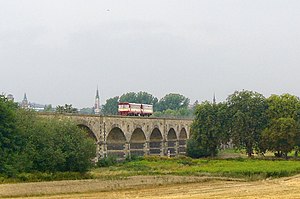Neisse Viaduct (Zittau)
Coordinates: 50 ° 53 ′ 33 " N , 14 ° 49 ′ 45" E
| Neisse Viaduct | ||
|---|---|---|
| Neisse Viaduct in Zittau | ||
| use | Railway bridge | |
| Convicted | Liberec – Zittau railway line | |
| Subjugated | Lusatian Neisse , narrow-gauge railway Zittau – health resort Oybin / health resort Jonsdorf | |
| place | Zittau / Porajów | |
| Entertained by | DB network | |
| construction | Arch bridge made of stone | |
| overall length | 745 m | |
| Number of openings | 39 | |
| height | 18 m | |
| building-costs | > 400,000 thalers | |
| opening | December 1, 1859 | |
| location | ||
|
|
||
The Neißeviadukt in Zittau , also called Neißetalviadukt , is a railway bridge over the Lusatian Neisse between Germany and Poland . The 745 meter long viaduct is one of the largest and oldest railway bridges in Germany. It was opened on December 1, 1859 with the railway line between Zittau and Reichenberg .
The viaduct spans the Neisse valley with 39 arches. In addition to the German-Polish border river, it also passes under the narrow-gauge railway into the Zittau Mountains and is located in the Zittau Ost district to the east of the confluence of the Mandau and the Neisse. The border river is spanned with only two arches, the middle one standing on a river island. The majority of the arches are located on the Zittauer Flur between the end of the approaching embankment coming from Zittau station and the Neisse. The smaller number of arches is on the side of the Polish village of Porajów . The railway line runs for 2.75 kilometers across Polish territory and then crosses the Polish-Czech border at Hrádek nad Nisou .
The Zittau Neisse Viaduct, like the Görlitz , was also to be blown up by Wehrmacht units on May 7, 1945 . The former cadets of the Armed Forces Dietrich Scholze prevented the demolition of the viaduct and thus risked his life for the preservation of the building. Scholze was a platoon leader for the railway pioneers who were supposed to blow up the viaduct. He had the ignition cables and detonators installed by his unit removed and thrown into the Neisse.
For a long time, the viaduct has been sinking evenly along its entire length, probably as a result of the Turów open-cast brown coal mine . Engineers have been surveying the viaduct every year since 1990 and between 1990 and 2002 they found it was eight centimeters lower. The maintenance of the bridge structure is the responsibility of DB Netz , which renovated it in 2002.
Web links
Individual evidence
- ^ A b Wilfried Rettig : Railways in the three-country corner. East Saxony (D), Lower Silesia (PL), North Bohemia (CZ). Volume 1: History of the main routes, operating points, electrification and route descriptions. EK-Verlag, Freiburg (Breisgau) 2010, ISBN 978-3-88255-732-9 , p. 59.
- ^ Wilfried Rettig: Railways in the three-country corner. East Saxony (D), Lower Silesia (PL), North Bohemia (CZ). Volume 1: History of the main routes, operating points, electrification and route descriptions. EK-Verlag, Freiburg (Breisgau) 2010, ISBN 978-3-88255-732-9 , p. 63.
- ↑ Holger Gutte: This is what the future of the border bridges looks like . In: Saxon newspaper . July 28, 2011 ( online [accessed May 2, 2012]).
- ↑ Elke Schmidt: Savior of the Neisse Viaduct celebrates its 85th birthday today . In: Saxon newspaper . October 1, 2011 ( online [accessed May 2, 2012]).
- ^ Rolf Hill: How the demolition of the railway viaduct was prevented . In: Saxon newspaper . February 6, 2010 ( online [accessed May 2, 2012]).
- ↑ Matthias Klaus: Bahn looks under the viaduct . In: Saxon newspaper . October 10, 2002 ( online [accessed May 2, 2012]).

